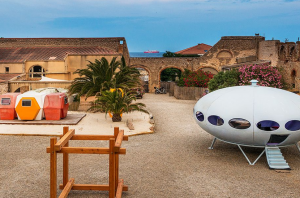Before their were tiny houses, there was Futuro House.
Utopie Plastic has introduced a collection of futuristic appearing micro-homes.
The dwellings are the newest exhibition at the Marseille, France’s Friche de L’Escalette sculpture park. As the video below reflects, there are versions of this home in the U.S. and a number of other nations worldwide.
The French exhibition is viewable by appointment, through October 1, 2017.
It has a unique place in factory-built housing history to share – including a look at early modular building and tiny-homes the way people imagined they would one day look.

Most interesting of all is taking a look at what designers and innovators came up with over 40 years ago, and how it compares to modular, prefab and tiny-homes available today.
The exhibition includes three rare micro-homes, which date from the 1960s and 1970s.
Utopie Plastic is centered around Matti Suuronen’s ‘Futuro House.’ Introduced in 1968, with 60 saucer-shaped micro-homes, they are now scattered across the globe, according to Opumo.
The ‘Futuro House’ was intended to be a holiday home that could be transported from place to place. More specifically it was designed as a skiing retreat, and originally cost $14,000, per Curbed.
Related article: Far Out Spaceship like Prefab Home Designs from the 1960s
Also found in the Marseille exhibition is Maison Bulle a Six Corques. That translates as the “Six-Shell Bubble House.” Created by French designer Jean-Benjamin Maneval, the Maison Bulle a Six Corques was introduced in 1956 as a prototype design that went into production over a decade later in 1968.

The flower-shaped homes originally came in green, white and brown, and are made of reinforced polyester, insulated with polyurethane foam. Utopie Plastic has two of these units – one of which is being restored on-site for visitors to view.
Jumping ahead to the 1970s, the exhibition also includes the 1972 Hexacube design by Georges Candillis and Anja Blamsfeld. The Hexacube is made of polyester and fiberglass, with a space-ship looking design that was inspired by the idea of colonizing other planets in a perceived sci-fi age to come.
The most unique feature about the Hexacubes is that multiple could be combined to make a larger residence. That concept is similar to modular homes the way we know them today.

This part of factory-built housing history shows how innovations preceded trends such as modular or tiny-homes.
Tiny-homes are growing in popularity across the U.S. and abroad, and are generally no more than 400 square feet – about the size of these micro-homes of the past.
While these uniquely designed and futuristic looking micro-homes are no longer in production, they are still a work of art – and they deserve being celebrated through the Utopie Plastic exhibition. ## (Lifestyle news, events.)
(Image credits are as shown above, and when provided by third parties, are shared under fair use guidelines.)
 manufacturedhomelivingnews.com Manufactured Home Living News
manufacturedhomelivingnews.com Manufactured Home Living News
































